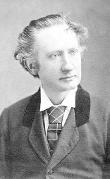Writer, librettist, actor, scenic artist.
The son of artist and lithographer, George Rowe (1796-1864), George Curtis Rowe initially followed his father's footsteps by becoming a scenic artist. By the time of his arrival in Australia in 1853, however, he had taken up acting. As George Fawcett he initially established his reputation in Victoria as a Dickensian actor, playing regional centres like Ballarat and Geelong and even in the goldfields themselves. Within a few years he more or less settled in Melbourne, and began writing for the stage as well as acting on it. Between 1859 and 1963 he leased the city's Princess Theatre, where he produced at least 15 of his own works. In 1862 he also produced David Copperfield, and from that production developed his sown interpretation of the character Wilkins Micawber. So popular was this representation that, according to Mimi Colligan and Veronica Kelly, 'he played it everywhere throughout his career' (p.222).
Other Fawcett dramas from this period included several comedietta adaptations - notably The Captain of the Vulture (based on the novel by Mary Elizabeth Braddon), which was presented after the main entertainment, Tom Jerry; Or, Life in London in August 1863. The Argus records that one of its features was the introduction of some spectral effects which had recently been used at the Haymarket Theatre (17 Aug. 1863, 5). Another concluding comedietta was The Chamber of Horrors, and during which Fawcett took on several characters then prominent in Professor Sohiers' waxworks exhibition.
Among George Fawcett's more popular theatrical works were his pantomimes, including Fortunio, or, The Seven Gifted Servants and Beauty and the Beast, both staged by the Gougenheim sisters in 1858; Harlequin Prince Humpy Dumpy (1859) and Harlequin Mother Hubbard and Puss in Boots (1861). His burlesques (original and adapted) included: Ye Storie of Il Trovatorie (1859), The Enchanted Isle (1859), Mydea - A Lesson to Husbands (1860), Masaniello (1861), Cupid and Zephyr (1861), and Puss in Boots (1862, a burlesque on his own pantomime). Another of his works, Endymion, The Naughty Boy Who Cried For the Moon (1861) was described in advertising as a "new classical, local and political extravaganza" and reportedly feature Fawcett impersonating the Postmaster General and several politicians (Argus 19 June 1861, 5).
Fawcett left Australia in 1864 for New Zealand, and a few years later travelled to the USA where he made his debut (as George Fawcett Rowe) in New York. He spent the remainder of his life alternating between America and England, and is believed to have written and staged as many as 40 plays. Arguably Fawcett's greatest success after leaving Australia was Fun on the Bristol: Or, A Night on the Sound (1879). Based on an outline developed by John F. Sheridan, the musical comedy starred Sheridan (in his greatest ever role as the Widow O'Brien) and served as a vehicle for variety sketches, comic and minstrel songs, dances and even opera selections. The work was a minor hit in New York, and Sheridan later toured it through America before taking it to England and eventually Australia. It's popularity was such that it remained a part of Sheridan's repertoire right up until his death.
Fawcett's English career was managed by Clarence Holt, father of Australian-based dramatist Bland Holt. Fawcett's connection with Australia continued even though he never returned, as Bland Holt produced one of his plays, a sensation melodrama, The New Babylon, in Australia in 1878. As Colligan and Kelly note, 'it was the forerunner here of dramas dealing with sport and society' (p.222). Despite his considerable output of original works and his ability to carve out an industrious career, Fawcett does not appear to have been able to capitalise financially from his efforts and in fact died impoverished in New York City in 1889.
[Sources: Mimi Colligan and Veronia Kelly's entry in the Companion to Theatre in Australia and the Australian Variety Theatre Archive]
 7625332511984703659.jpg
7625332511984703659.jpg
 7625332511984703659.jpg
7625332511984703659.jpg